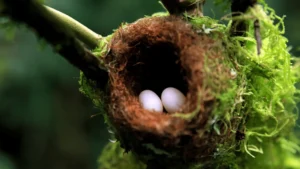Hummingbirds are one of the most unique and sensitive birds. Despite their small size, they possess extraordinary abilities that are fascinating to even bird experts. There are several species of hummingbirds, and one of the smallest among them is the Calliope hummingbird.
Let us dive into all you need to know about these beautiful Calliope hummingbirds.
Calliope Hummingbird Species
The calliope hummingbird (Species: Selasphorus calliope) is one of the smallest birds from the USA and Canada. The only smaller species ever found in the USA is the bumblebee hummingbird, an unintentional migrant from Mexico.
A fully grown calliope hummingbird could be 2-3 inches long, 4 inches wide on both wing tips, and weigh about 2+ grams. These hummingbirds are pretty fast and possess excellent flight skills to accompany their speed. ‘Calliope Hummingbird’ is dubbed after Calliope, the poet of magniloquence, who was the inspiration behind works like the Odyssey and Homer’s Iliad.
Male and Female Specie Distinctions

The magenta rays on the male’s throat are the most distinguishing feature of a Calliope Hummingbird. Males and females are greenish above, but males possess a greenish vest underneath, whereas females and infantile have a peachy wash across their underparts.
The back and top of calliope hummingbirds are polished green, with white underparts. The fully grown males have deep-red gorget flecks, green sides, and black rear, while females and immatures have pinky side washes, black specks on the throat, and a black tail with white tips.
Male Calliope Hummingbirds rent magenta rays from their throats as they dance and hover, executing U-shaped display dives for females. During these displays, the male makes a sputtering buzz with his tail feathers and an intense zinging call.
Behavior
Calliope hummingbirds are isolated creatures that solely interact with one another during the reproduction period. They are sectional, and males aggressively protect their reproduction and feeding areas from intruders. During the day, calliope hummingbirds spend their time straddling or fluttering above flowers in search of nectar, which they extract with a long extendable tongue.
Reproduction
Calliope hummingbirds are polygynous, which means they do not form pairs. From mid-April to early May, grown-up males naturally arrive on the breeding grounds before females. The male claims and fiercely protects a nesting territory where he will breed with a large number of females.
A male hovers, making a loud buzzing sound, with throat feathers protruding and facing a female during courtship. The male then temporarily surges up to about 20 metres and dives at high speed. This brilliant display is combined with vocalization to attract the female’s attention.
The male does not partake in raising the young and frequently leaves the breeding grounds before the young hatch. Typically, the female constructs an open cup nest by herself.
The Calliope Hummingbird reproduces in dry, open mountain woodlands and shrublands. The independent age is 20 days, and the baby is set to leave the nest.
Diet And Nutrition

Calliope hummingbirds are herbivores who eat nectar from flowers and drink sap from sapsucker holes. Also, they feed on small insects and spiders on occasion. If you are a hummingbird enthusiast, you can also set up a hummingbird feeder around you and make nectar solutions to feed these birds.
Habitat
Calliope Hummingbirds are more likely to be found in spring or summer, as they mostly migrate during these seasons. They are more prevalent in interior locations at higher elevations along rocky mountains in the fall. Besides high mountains, Calliope Hummingbirds live in forest clearings and valleys. Mature males often perch on open willow branches in high positions, giving them a complete overview of their territory, especially during the reproductive season.
Lifespan
The average lifespan of the Calliope Hummingbird is six years, and this figure can be slightly lower or higher depending on certain factors in the wild. The oldest recorded lifespan of a Calliope Hummingbird is eight years and one month old. Also, this was recorded on a female.
Disease
Calliope hummingbirds are naturally healthy birds, so only a few pathogens and disease syndromes have been identified. Most disease syndromes have little or no information on clinical signs and their difference across species. As a result, there is insufficient data to assess the effect of diseases on hummingbird populations, including those of conservation concern.
Hummingbirds are an exciting species for studying wildlife disease ecology due to unique characteristics. Furthermore, the feeding ecology of hummingbirds with prodigious diets of insects and nectar supports their consideration as environmental samplers; hummingbirds will assist as potential sentinels for assessing the environmental impacts of pollutants and pesticides.
More research is still needed to fish out diseases in hummingbirds thoroughly. However, Calliope hummingbirds are more vulnerable to natural disasters.
Frequently Asked Questions About Calliope Hummingbirds
Can I keep a calliope hummingbird as a pet?
No. Hummingbirds do not generally thrive in captivity, and their small size makes them difficult to care for. Nonetheless, zoos and aviaries worldwide have successfully provided for hummingbirds. Hummingbirds cannot survive in enclosed spaces. These adorable creatures are fantastic flyers and can take to the skies at a moment’s notice.
How do I identify a Calliope Hummingbird?
It is quite easy to identify a Calliope hummingbird. The magenta rays on the male’s throat are the most distinguishing feature of these Hummingbirds. Males and females are greenish above, but males possess a greenish vest underneath, whereas females and immatures have a peachy wash across their underparts.





